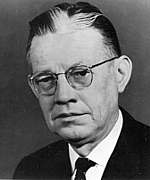When Dr. Wilhelm Klauditz died in a car accident on June 30th, 1963 during a business trip to Munich, the Institute for Wood Research experienced the most pivotal event in its history since the end of the war. Wilhelm Klauditz had been the propelling power behind the Institute and the point of convergence for the activities of the Verein für Technische Holzfragen e.V. (International Association for Technical Issues related to Wood). He had provided the impulse for the re-establishment of the Institute for Wood Research under the most unfavorable conditions, directly after the war, and had personally initiated and managed the essential research and cooperation. One year after his death, the Institute was renamed “Wilhelm Klauditz Institute for Wood Research” in his honor, thereby drawing attention to the unique character which Dr. Klauditz had given the Institute.
In 1903, the year in which Wilhelm Klauditz was born, wood research was still a young and barely-recognized scientific discipline. In the field of forestry science, a number of research facilities had already been established: in 1816, the Forstwissenschaftliche Akademie (Forest Sciences Academy) in Tharandt near Dresden, in 1830 a Forstakademie (Forest Academy) in Eberswalde and in 1868, a further academy in Hannoversch Münden. Material-related wood research as an independent field had, however, been neglected and was barely established institutionally until after the First World War.
After high school, Wilhelm Klauditz studied chemistry and in 1928, at the age of 25, he was conferred a doctor's degree in engineering science. He then received a grant from the Justus-Liebig Foundation, enabling him entry to the University in Halle, where he worked for a year as scientific assistant. In 1929, he joined the central laboratory of Koholyt GmbH in Cologne where, during the subsequent takeover of the company by Feldmühle AG, he was promoted to the position of Deputy Head of the research department in Odermünde near Stettin. In 1939, he left the company to become a scientific employee at the Reichsanstalt für Holzforschung (German National Institute for Wood Research) in Eberswalde near Berlin.
The foundation of the Prussian Institute for Wood Research in 1930 in Eberswalde, which would later become the Reichsanstalt für Holzforschung (German National Institute for Wood Research), is particularly owed to the commitment of Professor Dr. C. G. Schwalbe. The institute addressed the task of improving the wood usage of the German forestry sector through research and development work. In 1934, Professor Schwalbe left the institute, which was then divided into a mechanical-technological institute and a chemical-technological institute, from which the Institute for Wood Research was formed following the end of the Second World War. From 1939 onwards, the two independent institutes operated together under the name “Reichsanstalt für Holzforschung”.
Dr. Wilhelm Klauditz quickly established himself at the Reichsanstalt. In 1944, he became the head of the chemical-technological institute as successor to the deceased director Prof. G. A. Kienitz. The head of the mechanical-technological institute was the renowned wood researcher Franz Kollmann. At that time, the work of the Reichsanstalt addressed the development of more effective methods for the use of wood in order to diffuse the critical forestry situation under the conditions of the war economy.
The surrender of the German Reich also meant the end for the Reichsinstitut. The location in Eberswalde near Berlin lay directly within the front lines of the Red Army, which lead to an evacuation of the institute to makeshift premises; in February to Tyrol, and then in May to Hohenschwangau and Hohenpeißberg in Bavaria. The entire technical equipment, the library and much of the research of the Reichsinstitut were thereby lost. Under the worst conditions imaginable, the employees continued working for a further two months until July 1945, when the work finally had to be terminated due to lack of money.
Initially, Wilhelm Klauditz tried to safeguard the core of the staff for the re-establishment of an institute for wood research by suggesting its incorporation into the forestry department of the Technische Universität Munich. The TU, however, had other priorities, forcing Dr. Klauditz to seek a partially privately-funded solution.
Dr. Klauditz therefore contacted his former academic teacher Prof. Dr. Gustav Gassner in Braunschweig, who was the Principal of the Technische Universität Braunschweig after the war. Prof. Gassner was very interested in bringing the institute to Braunschweig, but the situation at the TU - completely ruined buildings and a desolate financial situation - did not allow the incorporation of the institute at the university. Dr. Klauditz therefore pursued the idea of financing the institute partly through donations from the industry. He found support at the Homogenholzwerken GmbH which, in December 1945, offered to accept a part of the costs for the continuation of the chemical-technical institute. This was the impulse which was necessary in order to motivate further sponsors. In spring of 1946, the idea of financing the institute through a “Verein für technische Holzfragen” (Association for Technical Questions related to Wood) was born. This idea was probably encouraged by Dr.-Ing. Hermann Winter, professor for aircraft construction and lightweight construction in Braunschweig. The support provided by the city, the forestry commission, the chamber of commerce, the university and the enterprises MIAG and Homogenholzwerke encouraged Dr. Klauditz to extend an invitation to attend the founding meeting of the Association on July 7th, 1946.
Under the name of “Versuchs- und Beratungsstelle für technische Holznutzung des Vereins für technische Holzfragen e.V.“, the institute moved into its rented rooms on Steinriedendamm in July 1946. The “building” was a hut of 260m², partly war-damaged and partly structurally incomplete. However, the space was sufficient and after three months of restoration, the first research work could begin. In August 1946, Dr. Klauditz went to Bavaria to collect the remaining equipment which had been saved there from the Reichsinstitut. The transfer was not simple, as Bavaria belonged not to the British but to the American occupation zone.
In 1949, when the institute was given the name “Institut für Holzforschung”, Dr. Klauditz had achieved his first goal: the number of members of the Association for Technical Issues related to Wood had increased steadily and now totaled 102. The financial background was now virtually secured. Whilst during the early years the research work had dealt with purely raw material-related issues, the main emphasis was now moving more and more towards the development of manufacturing methods for artificial wood-based materials.
In 1952 the Institute, in recognition of its outstanding scientific performances, was integrated into the Technische Universität Braunschweig; the funding remained thereby unaffected. The recognition of the particle board as the most important material for furniture is owed to the research work carried out by Dr. Klauditz during this time.
Dr. Klauditz experienced the laying of the foundation stone for the new Institute building - a matter that was close to his heart - and also the completion of the building in 1961; he did not, however, live to see the incorporation of the Institute into the Fraunhofer-Gesellschaft in 1972. The void left by his unexpected death in the accident in 1963 was so huge that it took five years to find a suitable successor for the management of the Institute.

 Fraunhofer Institute for Wood Research
Fraunhofer Institute for Wood Research 
